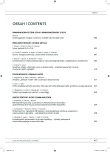Transnasal Endoscopic Surgery of the Pituitary Gland – the Benefit of Collaboration between Otorhinolaryngologist and Neurosurgeon
Authors:
P. Matoušek 1; R. Lipina 2; T. Paleček 2; T. Hrbáč 2; Pavel Komínek 1
Authors‘ workplace:
FN Ostrava
ORL klinika
1; FN Ostrava
Neurochirurgická klinika
2
Published in:
Cesk Slov Neurol N 2010; 73/106(5): 542-545
Category:
Short Communication
Overview
The authors describe an experience with the transnasal endoscopic approach to sellar region surgery. A neurosurgeon and an otorhinolaryngologist collaborated in operations upon 23 patients in the neurosurgery department of the University hospital Ostrava between March 2008 and December 2009. The endoscopic approach clearly benefits from keeping invasiveness to the minimum and making “four hands” surgery a viable option. The advantages of collaboration between neurosurgeon with otorhinolaryngologist are better orientation in the nasal cavity, the option of addressing any prevailing pathology immediately, and time savings in surgery arising out of the more highly-developed particular skills of the otorhinolaryngologist. Interdisciplinary collaboration in this procedure may become the basis for development of an advanced approach to skull base surgery.
Key words:
endonasal endoscopic surgery – sellar tumors – suprasellar tumors
Sources
1. Yano, S, Kawano, T, Kudo, M, Makino, K, Nakamura, H, Kai, Y et al. Endoscopic endonasal transsphenoidal approach through the bilateral nostrils for pituitary adenomas. Neurol Med Chir (Tokyo) 2009; 49(1): 1–7.
2. Cappabianca P, Cavallo LM, de Divitiis E. Endoscopic endonasal transsphenoidal surgery. Neurosurgery 2004; 55(4): 933–941.
3. Masopust V, Netuka D, Beneš V. Endonasální endoskopická transsfenoidální resekce selárních lézí. Cesk Slov Neurol N 2008; 71/104(6): 704–710.
4. White DR, Sonnenburg RE, Ewend, MG, Senior BA. Safety of minimally invasive pituitary surgery (MIPS) compared with a traditional approach. Laryngoscope 2004; 114(11): 1945–1948.
5. Česák T, Náhlovský J, Hosszů T, Řehák S, Látr I, Němeček S, et al. Longitudinální sledování růstu pooperačních reziduí afunkčních adenomů hypofýzy. Cesk Slov Neurol N 2009; 72/105(2): 115–124.
6. Sameš M, Vachata P, Saur K, Budíková M. Přímý transnazální miniinvazivní přístup pro mikrochirurgickou resekci adenomů hypofýzy. Cesk Slov Neurol N 2005; 68/101(5): 338–342.
7. Sonnenburg RE, White D, Ewend MG, Senior B. The learning curve in minimally invasive pituitary surgery. Am J Rhinol 2004; 18(4): 259–263.
8. Snyderman C, Kassam A, Carrau R, Mintz A, Gardner P, Prevedello DM. Acquisition of surgical skills for endonasal skull base surgery. A training program. Laryngoscope 2007; 117(4): 699–705.
9. Charalampaki P, Ayyad A, Kockro RA, Perneczky A. Surgical complications after endoscopic transsphenoidal pituitary surgery. J Clin Neurosci 2009; 16(6): 786–789.
10. Netuka D, Masopust V, Belšán T, Kramář F, Beneš V. První zkušenosti s použitím intraoperační MR při resekcích adenomů hypofýzy. Cesk Slov Neurol N 2008; 72/10 (Suppl 2): S20.
Labels
Paediatric neurology Neurosurgery NeurologyArticle was published in
Czech and Slovak Neurology and Neurosurgery

2010 Issue 5
Most read in this issue
- Pudendal Neuralgia – a Case Report
- Development of the PLIF and TLIF Techniques
- Cubital Tunnel Syndrome – a Review of Surgical Treatments and Comparison of their Outcomes
- Gunshot Wounds of the Head and Brain
